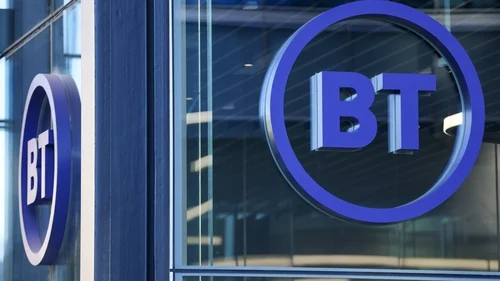One of the biggest changes in BT’s history is about to happen, and it has the potential to drastically alter the digital landscape in Britain. The company’s most recent round of investments in 5G connectivity and fiber infrastructure is a silent revolution—not through dazzling technological debuts, but through a purposeful, strategic restructuring of how a country connects, communicates, and competes.

The pace at which BT is growing its fiber rollout throughout the United Kingdom is remarkable. Now, more than 18 million locations have full-fiber broadband connections, a startling 33% increase over the previous year. These are more than just numbers; they stand for small businesses, hospitals, schools, and families that are now able to communicate more quickly and reliably. The company’s extremely ambitious aim of reaching 25 million locations by the end of 2026 demonstrates its commitment to bridging the connection gap in both urban and rural areas.
BT Group – Information and Highlights
| Category | Details |
|---|---|
| Company Name | BT Group plc |
| Established | 1846 |
| Headquarters | London, United Kingdom |
| Chief Executive Officer | Allison Kirkby |
| Market Capitalization | £12.3 billion (as of FY25) |
| Annual Revenue (FY25) | £20.4 billion |
| Adjusted EBITDA | £8.2 billion |
| Free Cash Flow | £1.6 billion (up 25% year-on-year) |
| Employees | 116,000 after restructuring |
| Focus Areas | Fiber Broadband (FTTP), 5G Networks, Digital Infrastructure |
| Reference | www.bt.com |
This change extends beyond smoother video calls or quicker streaming. The goal is to safeguard Britain’s digital infrastructure for the upcoming wave of creative thinking. The exponential growth of cloud computing, automation, and artificial intelligence makes the need for incredibly dependable connectivity unavoidable. In contrast to earlier copper networks, fiber broadband provides the scalability and consistency needed to manage this spike. With a record-breaking 36% take-up rate, BT’s Openreach division, which is at the forefront, has demonstrated not only adoption but also strong customer trust. Additionally, the company’s average revenue per user for broadband has increased by 6% to £16.0, demonstrating that consumers are becoming more and more prepared to pay for stability and quality.
In the meantime, BT’s rollout of 5G is progressing remarkably. With 40% of the population covered and more than 13 million 5G subscriptions, the business is setting the stage for a more mobile, data-driven economy. Particularly advantageous is the combination of 5G mobile services with fixed internet, which guarantees smooth connectivity for both consumers and businesses. The number of consumers who use BT’s landline and mobile services has increased to 24.6%, which is a definite sign of value alignment and brand loyalty.
In terms of finances, BT’s reorganization has been very successful. Adjusted EBITDA increased 1% to £8.2 billion, indicating improved operational management, despite a minor 2% decline in revenue brought on by the sale of non-core assets. Its free cash flow, which increased by 25% to £1.6 billion, is even more remarkable. A number of astute, efficiency-driven reforms, including automation of maintenance procedures, a drastic cut in energy expenses, and a reduction in the workforce to 116,000 personnel, were the driving forces behind this expansion. Together, these actions resulted in yearly gross savings of almost £900 million, demonstrating the company’s transformation’s ambition and effectiveness.
BT is reinvesting resources in digital development by concentrating on simplification. As fiber rollout stabilizes, capital expenditures are anticipated to decrease by over £1 billion starting in FY26, freeing up funds for shareholder rewards and technical reinvestment. The timing of this resource reallocation is especially creative since it enables BT to switch from building to optimization mode at the exact moment when demand for digital infrastructure rises.
BT’s investment has important wider economic and social ramifications. Reliable internet connection is becoming as essential as power or water in a nation where productivity is now defined by connectedness. BT is empowering small enterprises, facilitating flexible work arrangements, and facilitating easier family connections by extending fiber into isolated regions. Every aspect of daily life is being impacted by this shift, from hospitals implementing AI-based patient monitoring systems to rural entrepreneurs embracing e-commerce.
The leadership of BT is aware that its responsibilities go beyond only telecommunications. The company’s efforts directly support inclusion and national competitiveness. One example of how BT’s infrastructure supports vital national services is its continued relationship with the UK government on the Emergency Services Network, which has been extended until 2035. Furthermore, by reducing energy consumption and improving logistics, the emphasis on sustainable network operations supports Britain’s environmental objectives. BT does more than merely link people; it does so effectively and responsibly.
The financial outlook is especially encouraging for investors. BT is laying solid groundwork for long-term shareholder value, with estimates indicating free cash flow will increase to £2 billion by FY27 and £3 billion by the end of the decade. Few competitors can match its pricing strength and market supremacy because to its fiber dominance and steady 5G growth. Despite fierce competition from rivals like Virgin Media O2 and CityFibre, BT’s unmatched scale guarantees resilience. The company’s decades-old network reach continues to be a strong deterrent to entrance.
This optimism is starting to be reflected by analysts. In spite of short-term share price swings, almost half of those who follow BT currently recommend it as a “Buy,” citing its potential for long-term growth. For investors looking to gain exposure to Britain’s digital boom, the company offers an alluring opportunity, trading at about a 20% discount to its five-year average price-to-earnings ratio.
Beyond the figures, however, it is important to note the industrial and cultural impact of BT’s transition. Its transformation from an antiquated telecom operator to a trailblazing innovator in digital infrastructure reflects the greater narrative of contemporary reinvention. BT is incorporating artificial intelligence and advanced analytics into its network management systems through partnerships with industry leaders in technology, such as Microsoft and ISG. Predictive maintenance, intelligent routing, and self-optimizing systems will be made possible by these advancements, resulting in a network that can effectively govern itself with startling accuracy.
By utilizing these technologies, BT is establishing a standard for how national telecoms might develop into platforms that facilitate whole innovation ecosystems. Imagine connected classrooms that use AI to personalize instruction, smart cities that automatically adjust traffic flow, or energy grids that are adjusted based on real-time data. These innovations will be supported by BT’s network, which is subtly growing beneath the surface of daily life.
The change also signifies a change in the way society views internet access. Connectivity, which was once a convenience, is now a right, and BT’s investments are especially revolutionary in making sure that everyone has access to it. The company’s rural expansion, which has connected almost five million previously underserved locations, demonstrates an incredibly clear vision: that digital equality is a social responsibility as well as a business objective.
